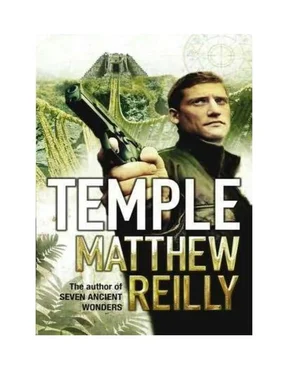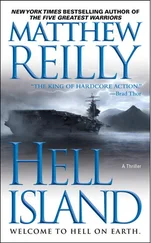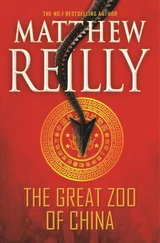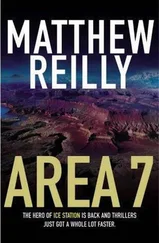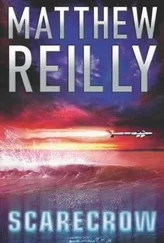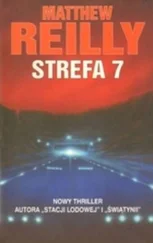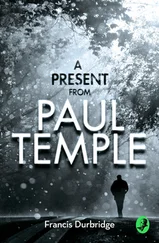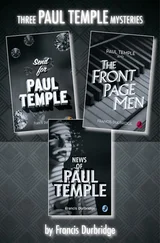It was Van Lewen. His bodyguard.
Defending him with his M-16.
Just then, one of the attack helicopters roared by overhead—its rotor blades thumping loudly, its white spotlight playing over the tower’s peak—and pummelled the muddy ground in front of Van Lewen with a burst from its sidemounted cannons, the incredible noise of the cannons drowning out the clatter of automatic gunfire on the tower top.
Frantic voices shouted over Race’s earpiece: “—Can’t see where they—”
“—too many of them!’
And then suddenly he heard Nash’s voice: “Van Lewen!
Cease fire! Cease fire!”
A second later, Van Lewen’s fire stopped and with it the gun battle, and in the eerie stillness that followed—bathed as it was in the harsh white light of the two attack choppers circling the tower top—Race saw that he and his companions were completely surrounded by at least twenty men, all of them dressed in black and armed with submachineguns.
The two attack helicopters began to hover above the clearing in front of the temple, illuminating it with their powerful spotlights. They were American-made AH-64 ‘Apache’ assault choppers—skinny, evil-looking attack birds.
Slowly, the group of shadowy figures began to emerge from the foliage at the edge of the clearing.
All of them were heavily armed. Some held compact German-made MP-5s, others carried extremely hightech Steyr-AUG assault rifles.
Race was surprised at himself, surprised at his knowledge of the range of weapons before him.
It was all Marty’s fault, really.
Apart from being a design engineer at DARPA and the world’s most annoying Elvis Presley fan (all of his PIN numbers and computer passwords were the same number—53310761—the King’s Army serial number), Race’s “brother Marty was also a walking encyclopaedia on guns.
Ever since they were kids, right up to the last time Race had seen him nine years ago, whenever they visited a sporting goods store, Marty would be able to identify for his younger brother every make, model and manufacturer of the guns in the firearms section. The strange thing was that now, thanks to Marty’s incessant observations, Race suddenly found that he, too, could identify them all.
He blinked, came back to the present, resumed his view of the phalanx of armed commandos gathered in front of him.
They were all dressed in black—jet-black combat fatigues, jet-black webbing, jet-black gloves and boots.
But by far the most striking feature of their uniforms was on their faces. Each soldier wore a charcoal-coloured porcelain hockey mask over his face a solid black featureless mask that covered everything but its wearer’s eyes. The masks made the soldiers in front of Race look cold, inhuman, almost robotic.
Just then one of the masked commandos hurried over to where Van Lewen was standing and snatched his M-16 away from him, hastily relieved him of his other weapons.
Then the black-clad man leaned down toward Race and smiled through his menacing black mask.
‘Guten abend,” he said wryly before yanking Race roughly to his feet.
The rain continued to fall.
Nash, Copeland and Lauren stood by the portal, their hands clasped tightly behind their heads. The Green Berets stood next to them, disarmed.
Walter Chambers stared wide-eyed and stunned at the squad of masked commandos surrounding them. Gaby Lopez just eyed them all coolly.
Van Lewen and Race were shoved alongside the others.
Race gazed fearfully at the black-clad soldiers, stared at their cold black hockey masks. He had seen masks like that before. South American riot police wore them during extremely violent protests, to protect their faces against rocks and other hurled objects.
He counted about twenty soldiers in total.
Standing in the darkness behind the circle of commandos, however, was another group of people—men and women. This new group of people were not dressed in uniforms or masks. They wore civilian clothes, hiking clothes not unlike Lauren’s.
Scientists, Race thought. German scientists who had come here in search of the thyrium idol.
He glanced over at the portal, at the huge boulder wedged inside its doorway. Wires protruded from every side of it—the soft-detonating C-2 explosives.
Just then, one of the commandos stepped forward and reached up to remove his black hockey mask.
Race tensed with anticipation—waited to see the cold hard features of Heinrich Anistaze, the former Stasi agent who had led the squad of German assassins in the bloody slaughter at that monastery.
The commando removed his mask.
Race frowned. He didn’t recognise him.
It wasn’t Anistaze.
Rather, he was a stout, older man, with a round, creased face and a bushy grey moustache.
Race wasn’t sure whether to be relieved or terrified.
The German leader didn’t say a word as he brushed roughly past Race and crouched down in front of the portal.
He examined the assorted wires leading out from the boulder and snorted. Then he dropped the cables and walked over to Frank Nash.
He stared imperiously down his nose at the retired Army colonel, evaluating him, appraising him.
And then suddenly he spun around and barked an order to his troops.
“Feldwebel Dietrich, bringen She she in das Dorf und sperren She she ein! Hauptmann von Dirksen, bereiten She alles vor um den Tempel zu offnen.’
Race translated the words in his head: ‘Sergeant Dietrich, take them to the village and lock them up. Captain Von Dirksen, prepare to open the temple.’
Led by a German sergeant named Dietrich and surrounded by six of the masked German commandos, the ten Americans were marched unceremoniously back across the rope bridge and down the spiralling pathway.
When they came to the bottom of the path, they were directed through the narrow fissure in the plateau that led back to the riverside path.
After about twenty minutes of walking, they arrived back at the village.
But the village had changed.
Two enormous halogen floodlights illuminated the main street, bathing it in artificial light. The two Apache helicopters that Race had seen up on the tower top now sat at rest in the middle of the street. About a dozen German troops stood at the river’s edge, staring out at the river.
Race followed their gaze and saw his team’s battered Hueys resting up against the edge of the riverbank. When seen alongside the two sleek Apaches, Frank Nash’s Hueys seemed old and clunky.
It was then that Race saw what the German commandos were really looking at.
It lay beyond the two Hueys, resting on the river’s surface, cloaked in the steadily falling night rain.
A seaplane.
But this was no ordinary seaplane. It must have had a wingspan of at least two hundred feet. And its underbelly—that part of it that rested majestically in the water—was absolutely enormous, easily larger than the main body of the Hercules that had flown Race and the others into Peru. Four turbojet engines were slung underneath its massive wings, while two bulbous pontoons stretched down from each wing, touching the water’s surface, stabilising the aircraft.
It was an Antonov An-111 Albatross, the largest air-capable seaplane in the world.
The big plane was rotating slowly on the river’s surface as Race and the others emerged from the riverside path led by the German sergeant, Dietrich. It was reversing in toward the riverbank.
No sooner had it run aground in the soft mud than a loading ramp began to lower from its hindquarters.
As soon as the ramp touched dry land, two vehicles rumbled out from within the giant plane—-one eight-wheeled all-terrain vehicle that looked like a tank on wheels, and one hard-topped Humvee.
The two armoured vehicles skidded to a stop in the middle of the main street. Race and the others were led toward them. As they arrived at the two cars, Race saw two more German commandos shoving Tex Reichart and Doogie Kennedy down the street toward them.
Читать дальше
